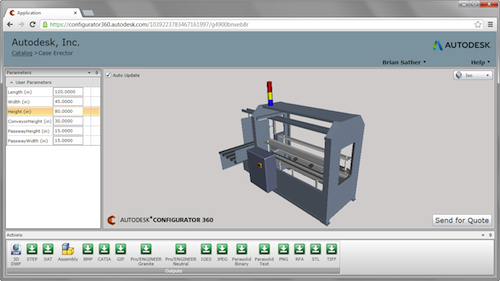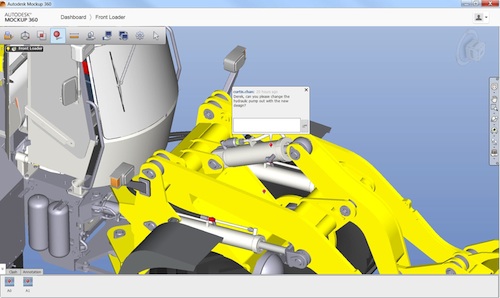July 16, 2013
First it seemed like Autodesk was just talking up the cloud. Then the maker of professional design software embraced the cloud as a springboard for a whole new family of consumer-oriented design capabilities. Now, Autodesk is back in the cloud spotlight with a pretty robust lineup of services intended to bring flexibility, compute scalability, and more collaborative interaction to professional design engineers.
On the heels of its official debut of Autodesk Fusion 360 late last month, Autodesk unveiled a trio of offerings: Autodesk Sim 360, a cloud-based, lightweight application for mechanical simulation and finite element modeling; Autodesk Mockup 360, a cloud-based, real-time collaboration and digital mockup tool; and Autodesk Configurator 360, a cloud-based configuration service. These latest additions are based on the Autodesk 360 cloud-based design platform, which launched in September 2011 and which Autodesk claims has already been accessed by 15 million users.
While Autodesk says small, entrepreneurial businesses (actually what they call very small businesses) are the most avid adopters of the new cloud-based tool portfolio, it claims companies of all sizes are experimenting with the new paradigm, according to Richard Blatcher, Autodesk’s senior global industry marketing manager. What’s interesting, though, is rather than companies choosing between a traditional or cloud-based delivery model for their design tool software, Autodesk sees companies leveraging both styles depending on the particular workflow—a scenario Blatcher likens to the evolution of working in both 2D and 3D depending on the task.
“It’s not a decision of whether to work traditionally or work in the cloud, it’s an ‘and’ play,” he explains. “A huge number of customers will continue to work in Inventor and add [cloud-based] services at their own pace.”
Where Blatcher and other Autodesk execs see the value of the cloud is in its flexibility to accommodate what’s fast become a nearly universal need to collaborate on designs with outside partners, suppliers, customers, and even outsourced engineering teams. “Many traditionalists think organizations operate independently in closed bubbles of their own, but that’s not correct in today’s marketplace,” notes Steve Hooper, Autodesk’s senior product line manager for mechanical design.
While the universal hurdle to the adoption of cloud-based design software (really any kind of cloud-based software) has been concerns around security, Autodesk says companies are getting more comfortable with the model. Moreover, the tried and true way of sharing engineering IP and CAD models across a dispersed design team has been email or Federal Express—both of which have their own inherent security risks, Hooper says. “It’s infinitely more secure to share IP through a professionally managed cloud-based service,” he says. “To see the cloud as a risk is to ignore how people do business today and to ignore the market drivers in terms of global supply chain collaboration.”
For Redpoint Studios, a product development shop, the addition of cloud-based tools provides far more flexibility as to where the engineering team physically works with the design data and alleviates the need for complex IT infrastructure like Virtual Private Networks (VPNs) and massive server storage.
“A system that does not require a server for collaboration, works across OS platforms, and can offload heavy computing to the cloud really reduces the IT budget requirements,” says Scott Leonard, Redpoint Studios’ principal of engineering. Providing customers with access to latest design data is another big driver, Leonard says.
Here’s a snapshot of how the new Autodesk 360 offerings stack up in terms of flexible collaboration capabilities and the ability to access simulation, digital mockup, or product configuration capabilities from any where without being tied to a desktop:
Mockup 360: This cloud-based, real-time collaboration and design mockup tool will allow engineering groups to capture and aggregate CAD data from various sources and formats (we’re talking PTC’s ProE, SolidWorks, STEP, and IGES files and the list goes on, Autodesk says) and bring it together in one environment. Up to 500 people can be online concurrently connected to the same model, Autodesk says, allowing them to create markups, edit positions, and check for interferences without the need to install desktop solutions.
Configurator 360: This cloud-based service improves productivity and reduces cycle times, allowing companies to deliver an online catalog of products to customers and sales reps for the purposes of building custom models for quoting or for new product design. Accessed via a browser or mobile app, users start by uploading an Inventor or Inventor Engineer-to-Order (ETO) part or assembly to Configurator 360, which then identifies the parameters or rules as defined in iLogic or ETO, providing the ability to define customization options before deploying the configurator. Check out this video first look on 360 Configurator by my colleague, Kenneth Wong:
Sim 360: Building on what it announced last September, Autodesk took the wraps off of Sim 360, which addresses a key problem Autodesk heard from customers—that they were lacking the computational resources to do mechanical simulation on any grand scale, according to Derrek Cooper, senior product line manager for simulation. In addition to the ability to access more than one physics (there are FEA, CFD, and Moldflow capabilities), Sim 360 provides a cloud-connected workflow for simulation, which can store data locally in house while leveraging the infinite computing resources of the cloud to do the heavy computational lifting. Now, instead of being limited to two or three simulations, companies can run many more simulations concurrently, which leads to more effective design optimization, Cooper says.
All of the new 360 products, including Fusion 360, are available for a free 90-day trial. Below is a video first look on Autodesk’s companion cloud-based CAD offering, 360 Fusion:
.
Subscribe to our FREE magazine, FREE email newsletters or both!
About the Author
Beth Stackpole is a contributing editor to Digital Engineering. Send e-mail about this article to [email protected].
Follow DE







